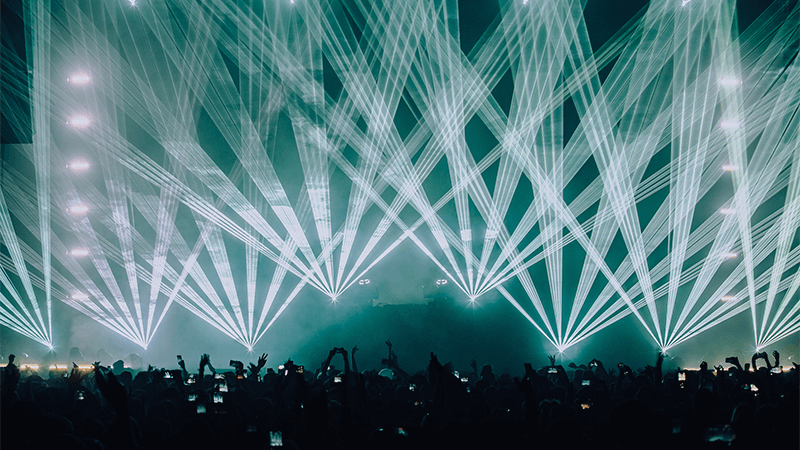Concert laser lights have transformed the live music experience, turning it into a multi-sensory feast for the eyes and ears. These brilliant displays entrance audiences, guiding them through a visual odyssey that enhances the tunes and harmonies of their favorite bands and artists. Let's delve into the fascinating realm of concert laser lights, their origins, the different types, and how they create a symphony of stunning visuals.
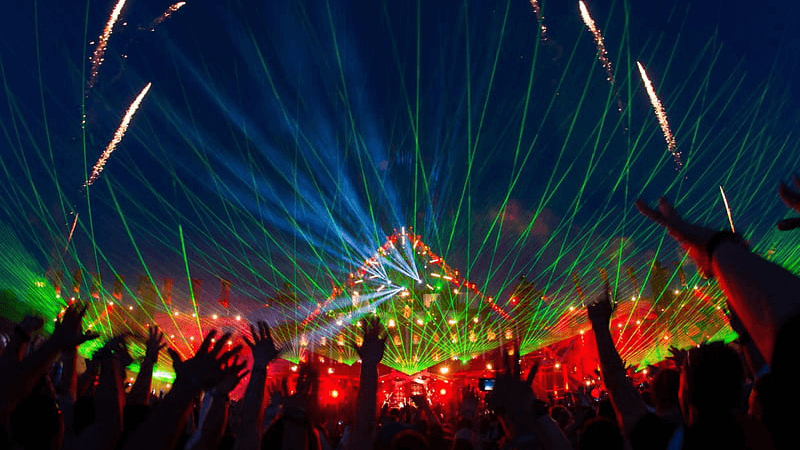
A Brief History of Concert Laser Lights
From Sci-Fi to Concert Stages
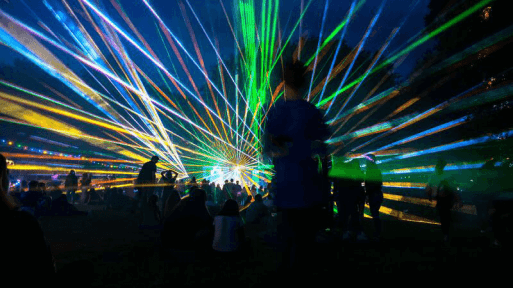
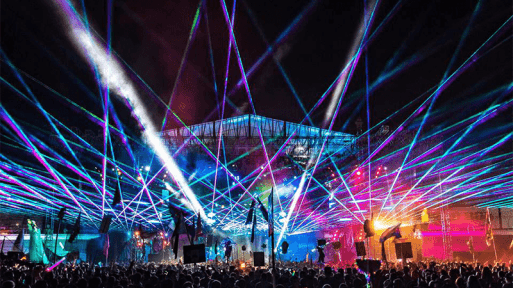
The story of concert laser lights commenced in the 1960s with the invention of the first lasers. At the time, lasers seemed like a futuristic technology straight out of a science fiction novel. Nevertheless, creative minds quickly recognized their potential in the entertainment industry. Concerts began incorporating laser light machines in the 1970s, and these mesmerizing displays quickly became a staple of live performances.
The Evolution of Stage Laser Lights
Over time, stage laser lights have advanced significantly. Technological developments have led to more sophisticated and intricate displays. Here's a look at the key milestones in the evolution of stage laser lighting:
- 1970s: Early adopters of stage laser lights, like Pink Floyd and Led Zeppelin, used basic single-beam lasers to create straightforward visual effects.
- 1980s: The emergence of multi-colored lasers and computer-controlled systems provided light technicians with greater creative freedom in designing shows.
- 1990s: The introduction of digital technology facilitated even more complex patterns and visuals, with artists like Madonna and U2 embracing cutting-edge stage laser light displays.
- 2000s to present: Concert laser lights have grown increasingly versatile, incorporating 3D mapping, synchronized pyrotechnics, and other innovations to create immersive visual experiences.
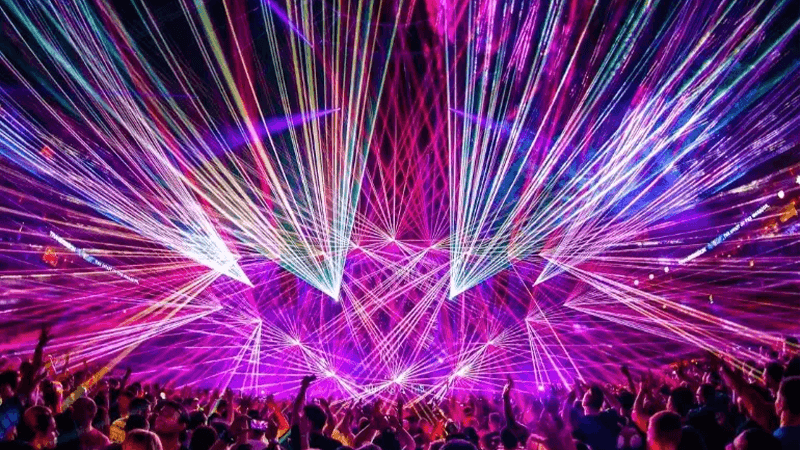
The Different Types of Laser Lights Concert-Goers Love
1. Beam Lasers
Beam lasers are the most common type of laser lights machine used in concerts, creating intense, focused beams of light that shoot across the stage and venue. They come in various colors, and their intensity can be adjusted to generate different effects. These lasers are often used in conjunction with fog or haze machines to enhance their visibility.
2. Aerial Lasers
Aerial lasers produce dazzling patterns and shapes in mid-air, often used to project images and designs onto surfaces like walls or ceilings. They can be combined with other lighting elements, like LED screens, to create immersive environments for the audience, making laser lights for stage performances a must-have.
3. Laser Graphics
Laser graphics are a more advanced form of dance laser light, allowing the projection of intricate images and animations onto surfaces. These laser light machines are often used to create custom visuals for specific songs or moments during a performance, adding extra depth and meaning to the show.
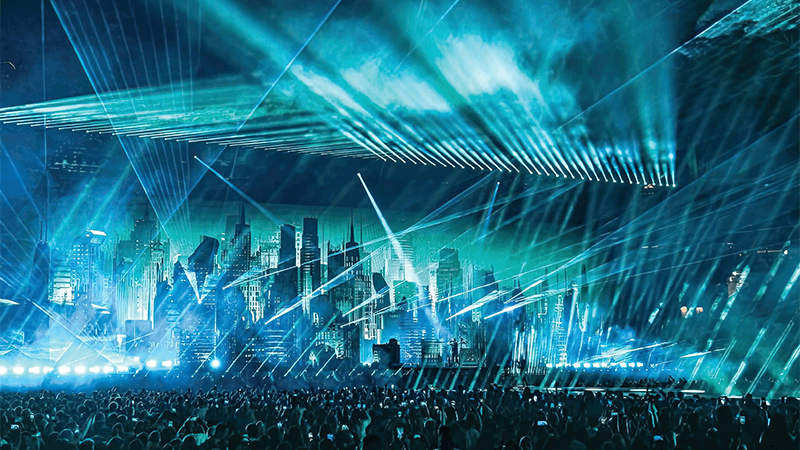
The Role of Concert Laser Lights in Live Performances
Setting the Atmosphere: Flat laser light displays play a crucial role in setting the atmosphere and tone for a live performance. The colors, patterns, and intensity of the moving laser light can evoke emotions and establish a connection between the audience and the music.
Enhancing the Music: Laser light effects can also accentuate specific elements of the music, such as highlighting a particular instrument, emphasizing a dramatic moment, or syncing with the beat to create a dynamic laser light stage experience.
Creating a Memorable Experience: A well-designed swamp laser light show can leave a lasting impression on the audience, making the concert an unforgettable experience they will cherish for years to come.
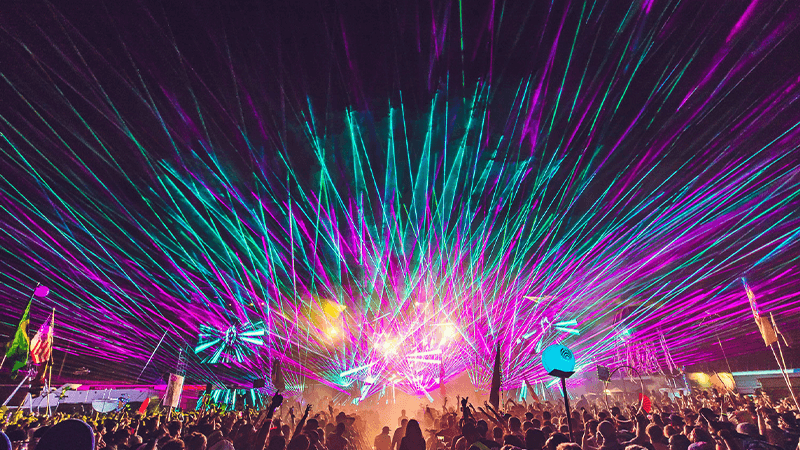
What are the important factors when choosing Concert Laser Lights?
1. Brightness and Power
✦Brightness
Brightness is a key indicator that determines the visibility of laser lights in the performance environment. For large concerts or outdoor performances, higher brightness laser lights are required to ensure that the laser effects are still clearly visible at a longer distance and in strong ambient light. Generally speaking, brightness is measured in lumens. Higher lumen values mean brighter light. For example, in a large stadium performance, a laser light with a brightness of thousands of lumens may be required to allow the audience sitting in the distant audience seats to clearly see the laser effects.
✦Power
Power is closely related to brightness, and generally the higher the power, the higher the brightness. The power of laser lights is measured in watts (W). However, it should be noted that high-power laser lights may pose safety risks, such as damage to human eyes. For small indoor concerts, laser lights with a power of between 1 and 5 watts may be sufficient; for large outdoor performances, laser lights with a power of more than 10 watts may be required. At the same time, in many countries and regions, there are strict safety regulations and licensing requirements for the use of high-power laser equipment.
2. Color and color effects
Laser lights can only provide three colors: red, green, and blue. These three colors can produce a variety of color effects by mixing; good color mixing is very pure, can accurately mix colors, can maximize overlap, and produce smooth and uniform color transitions. For example, in a concert with the theme of "Fantasy Wonderland", laser lights that can produce soft light blue and lavender gradient effects can create a very romantic atmosphere.
3. Beam quality and pattern effects
✦Beam quality
A high-quality beam should be clear and sharp. Check the beam divergence angle of the laser light. A smaller divergence angle means that the beam can travel a longer distance without excessive diffusion. For example, on a large stage, if the beam divergence angle is too large, when the laser shines to the back of the stage, the beam will become very wide and lose its original focusing effect. Generally speaking, the beam divergence angle of laser lights used for performances is preferably between 1 and 5 milliradians (mrad).
✦Pattern Effects
Laser lights can produce a variety of patterns, such as dots, lines, geometric shapes (such as circles, squares), complex patterns, etc. Choosing laser lights with rich pattern effects can add more creativity to the performance. Some laser lights also support custom pattern functions, and users can create unique patterns through software or built-in pattern editors. For example, in a performance with a sense of technology, laser lights that can project circuit board patterns or sci-fi style symbols can fit the theme well.
4. Scanning speed and motion effects
✦Scanning speed
The scanning speed determines how quickly the laser light can change the direction and position of the beam. For fast-paced music performances, a higher scanning speed is required to keep up with the rhythm of the music and create dynamic and lively visual effects. Scanning speed is usually measured in degrees/second (°/s). For example, some laser lights used for electronic music performances can scan at speeds of more than 40,000°/s, which can quickly switch the beam position between the stage and the audience area.
✦Motion effects
Consider the movement mode of the laser light, such as shaking head, swinging, etc. Laser lights with multiple motion modes can cover the performance space more flexibly. Some laser lights can also be programmed to achieve complex motion trajectories, such as spirals and waves, to create unique spatial visual effects for the performance. For example, in a dance performance, the beam of the laser light can move according to the dancer's motion trajectory, enhancing the interactivity and viewing of the performance.
5. Control method
Control method
There are many ways to control laser lights, including manual control, DMX control and software control.


In Conclusion: The Magic of Concert Laser Lights
From laser light for ceiling effects to laser light dancers, concert laser lights have come a long way since their inception in the 1970s. Today, they are an essential component of live music performances, enhancing the overall experience for audiences and artists alike. The mesmerizing visuals created by dancing laser lights add depth and emotion to the music, leaving concertgoers with lasting memories of the event.
From beam lasers and aerial lasers to laser graphics, flat laser lights continue to push the boundaries of what's possible in live entertainment. As technology evolves, we can expect even more innovative and spectacular displays in the future, further cementing the role of concert laser lights as a key element of the live music experience.
FAQs
- Are concert laser lights safe for the audience? Yes, when used correctly and following safety guidelines, concert laser lights are safe for the audience. Professionals handle the setup and operation of these lights to ensure they do not pose any risks.
- How are concert laser lights controlled during a live performance? Concert laser lights are typically controlled by a lighting technician or designer who uses specialized software and hardware to manipulate the lights in real-time, syncing them with the music and other visual elements of the show.
- Can concert laser lights cause damage to cameras or other electronic devices? While there have been instances where direct exposure to a high-powered laser beam has caused damage to camera sensors, such cases are rare. It's best to avoid pointing cameras directly at the lasers for extended periods to minimize the risk of damage.
- Are there any legal restrictions on using concert laser lights? Depending on the country and jurisdiction, there may be regulations governing the use of lasers in public events, including concerts. Event organizers should check local laws and obtain any necessary permits to ensure compliance.
